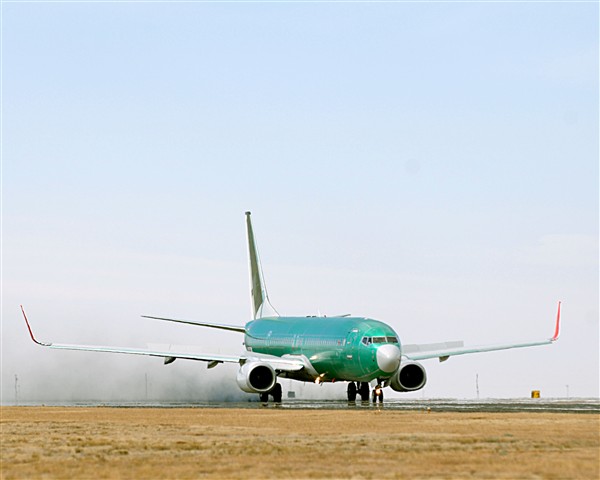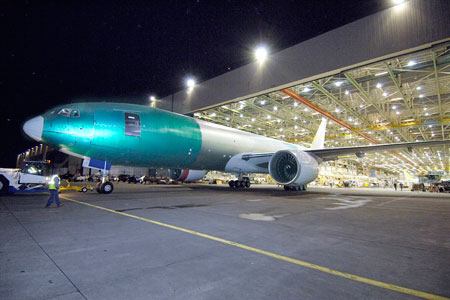First flight of the Embraer Phenom 300 Executive Jet.
Month: May 2008
Europe’s first 737-900ER delivered to Futura (GECAS)
The Boeing Company last week delivered Europe’s first two Next-Generation 737-900ER (Extended Range) airplanes to GE Commercial Aviation Services (GECAS) and its leasing customer, Spanish carrier Futura International Airways, based in Palma de Mallorca.
Futura International Airways was created by Aer Lingus in 1989. It operates a fleet of 32 Boeing airplanes and transports more than 3 million passengers a year. Its long-haul services include Canada, Indonesia, Chile, Dominican Republic, Brazil, Egypt and Gambia.

Boeing launched the 737-900ER program in July 2005. The 737-900ER, the newest member of the Next-Generation 737 airplane family, increases the capability of the 737 by carrying more passengers and flying farther. The European Aviation Safety Agency
(EASA) certified the 737-900ER April 22.
The twin-engine jet incorporates a new pair of exit doors and a flat rear-pressure bulkhead that allow a maximum capacity of 220 passengers in a single-class layout.
Aerodynamic and structural design changes, including strengthened wings, a two-position tailskid, enhancements to the leading and trailing-edge flap systems, optional Blended Winglets and auxiliary fuel tanks, will allow the 737-900ER to accommodate higher takeoff weights and increase its range to 3,200 nautical miles (5,900 km). The 737-900ER has substantial economic advantages over heavier competing models including 6 percent lower operating costs per trip and 4 percent lower operating costs per seat mile.
As of March 31, nine customers have placed orders for 229 Next-Generation 737-900ERs, and more than 7,900 orders have been placed for 737s. Boeing has more than 2,100 unfilled orders for the Next-Generation 737.
Source: Boeing
Photo Credit: Boeing
Video – Northwest Airlines Hamilton H-47
Have a look at a 1929 Hamilton H-47, one of the first airplanes Northwest Airlines used for passenger service.
Government of Iraq orders Boeing 737 – Agreement for 787
Boeing and the Government of Iraq recently announced an order for 30 Boeing 737-800 commercial airplanes, the first step in re-establishing that country’s scheduled commercial aviation operations. Iraq has also contracted options for 10 additional 737s.
Valued at $2.2 billion at current list prices, the order was previously accounted for on Boeing’s Orders & Deliveries Web site attributed to an unidentified customer.
In addition, Iraq and Boeing are finalizing an agreement for 10 Boeing 787 Dreamliners, which will allow an Iraqi national airline to provide longer-range commercial service. The 787s will be added to Boeing’s order book when the contract is completed.
In recent months Boeing and Iraqi officials have discussed how Boeing can assist with the reconstruction of Iraq’s aviation infrastructure and preparation for delivery and operation of new airplanes. Boeing will offer advice and expertise in areas such as the planning and development of airport infrastructure throughout Iraq; helping train aviation sector personnel; aiding in the selection and acquisition of airline support equipment; and arranging for cost-effective maintenance and service solutions for used aircraft obtained prior to new airplane deliveries.
Source: Boeing
Allegiant Air MD80 Overran Runway
An Allegiant Air MD80 overshot the runway at the Loveland/Fort Collins airport (near Denver) Sunday afternoon. The plane was coming back from Las Vegas.
No one of the 145 passengers and 5 crew members was hurt.
Video
Boeing Completes 737 Carbon Brakes Certification Testing
Boeing recently completed certification testing of new carbon brakes designed for the Next-Generation 737 airplane family by French supplier Messier-Bugatti.
A Next-Generation 737-900ER (Extended Range) airplane is shown performing a high-speed rejected takeoff test, designed to verify that an airplane at maximum weight with greatly worn brakes can stop safely after a refused takeoff decision. Boeing will submit the test results to the U.S. Federal Aviation Administration for certification the second quarter this year. Entry into production is expected by third quarter. Boeing will offer a retrofit program for airplanes already in service.

Through a month-long test program, Boeing reached its goal to show equivalent performance between steel and carbon brakes, and verified a weight savings of 700 pounds (320 kg) compared to high-capacity steel brakes for Next-Generation 737-700/800/900ERs, and 550 pounds (250 kg) on standard-capacity steel brakes for Next-Generation 737-600/700s. Reduced weight contributes to reductions in associated fuel burn and CO2 emissions depending on airline operations.
The Messier-Bugatti carbon brakes are available as a new feature.
Source: Boeing
Photo Credit: Boeing
Air France’s 50th 777 Delivered
Boeing and Air France reached a historic milestone last week with the delivery of Air France’s 50th 777. The Boeing 777-300ER (Extended Range) is the carrier’s 25th of that model type and joins a fleet of another 25 777-200ERs that together comprise the core of the airline’s long-haul fleet.

Air France is the launch customer for Boeing’s newest addition to its freighter family, the 777 Freighter – the first of which is scheduled to enter flight test in late May. With more than 50 percent of its twin-aisle fleet composed of Boeing 777s, Air France has drawn upon the 777’s renowned efficiency and reliability to help it achieve strong economic performance. With the delivery of its first 777 Freighter this year and through the operation of a single 777 platform, Air France will achieve significant synergies between its cargo and passenger business.
Air France’s new 777-300ER, the world’s largest long-range twin-engine jetliner, will be based at Charles de Gaulle International Airport in Paris.
Source: Boeing
Photo Credit: Boeing
Final Assembly Begins on Fifth Boeing 787 Dreamliner
Final assembly began yesterday on the third flight-test airplane for the all-new Boeing 787 Dreamliner.
This is the fifth Dreamliner to be loaded into the first position of the 787 production system. The static test airframe moved April 25 from the Final Assembly to its test rig in another bay of the Everett, Wash.-based factory. Both the fatigue test airframe and the second flight-test airplane have advanced to the next position in production, where assembly and systems installation work continues.

“We are receiving assemblies that are much more complete,” said Jack Jones, vice president of 787 Final Assembly and Change Incorporation. Jones replaces Steve Westby, who retired from Boeing yesterday after a 31-year career. “The second flight-test airplane had a 50 percent reduction in the amount of incomplete work as compared to the first airplane. ‘Traveled work’ on this airplane is 65 percent less than on the first.”
After assembly is complete, this airplane will be fitted with an interior as part of the comprehensive flight-test program and
certification process.
“When that happens this summer, it will be the first time we’ll see the 787 in what is close to a final delivery configuration,” Jones said.
The first airplane to fly is on track for “power on” in June.
Around the world, 25 airplanes are in various stages of production. This number includes the static and fatigue airframes, which will not be delivered to customers. Since its launch in April 2004 the 787 Dreamliner has amassed nearly 900 firm orders valued at $151 billion from 58 airlines.
Source: Boeing
Photo Credit: Boeing
First Boeing 777 Freighter Leaves Factory
Progress continues on the first Boeing 777 Freighter as Boeing’s newest cargo airplane was towed out of its factory in Everett, Wash. and onto the flight line Tuesday night. Work will continue on the 777 Freighter to prepare for flight test this summer and to paint the airplane in the Boeing livery.

Source: Boeing
Photo Credit: The Boeing Company
